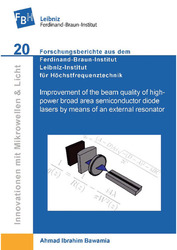| Areas | |
|---|---|
| Serie de libros (96) |
1377
|
| Nachhaltigkeit |
3
|
| Gesundheitswesen |
1
|
| Letra |
2361
|
| Ciencias Naturales |
5403
|
| Matemática | 229 |
| Informática | 318 |
| Física | 979 |
| Química | 1362 |
| Geociencias | 131 |
| Medicina humana | 243 |
| Estomatología | 10 |
| Veterinaria | 108 |
| Farmacia | 147 |
| Biología | 835 |
| Bioquímica, biología molecular, tecnología genética | 121 |
| Biofísica | 25 |
| Nutrición | 45 |
| Agricultura | 1004 |
| Silvicultura | 201 |
| Horticultura | 20 |
| Ecología y conservación de la tierra | 148 |
| Ciencias Ingeniería |
1788
|
| General |
97
|
|
Leitlinien Unfallchirurgie
5. Auflage bestellen |
|
Erweiterte Suche
Improvement of the beam quality of high-power broad area semiconductor diode lasers by means of an external resonator (Volumen 20) (Tienda española)
Ahmad Ibrahim Bawamia (Autor)Previo
Indice, Datei (52 KB)
Lectura de prueba, Datei (120 KB)
The operation of high-power broad area laser diodes in an external resonator is studied with respect to the improvement of their lateral beam quality. A simple setup with a broad area laser diode as gain medium, two lenses and an external mirror is considered. The concept relies on the ability of the active region of the laser diode to act as a spatial filter for higher order modes oscillating inside the resonator.
The geometries of the external cavity laser that favor fundamental mode operation in the lateral direction are inferred with the help of a theoretical model based on the ABCDmatrix treatment of Gaussian beams in a passive stable resonator. Thermal lensing that arises in the broad area laser diode is included in the model. The simulation results show that, for a given strength of the thermal lens arising inside the broad area laser diode, there exists one geometry of the external resonator that produces single mode operation as well as a high overlap between the optical mode and the gain medium of the laser diode.
A novel experimental procedure that quantifies the thermal lens arising in the broad area laser diode to be used inside the external resonator is developed. The thermal lens coefficient is determined for different injection currents and pulse widths. The reliability of the method is validated by the comparison of the obtained results with values of the thermal lens coefficient derived from independent measurements and from the simulation of the temperature distribution inside the laser diode. Furthermore, the latter simulation at different pulse widths enables to explain the observed saturation of the thermal lens coefficient as injection current and pulse width are increased.
The external cavity laser comprising a test broad area laser diode that emits at a wavelength in the region of 1.06μm, two lenses, and an external mirror is implemented. Additionally, an adjustable intra-cavity slit that serves as a supplementary spatial filter is inserted in the setup. The evolution of the output power and of the beam quality of the device as a function of the length of the resonator and of the width of the slit is studied at injection currents of 1A (close to laser threshold) and 5A (high power operation).
It is observed that at both injection currents, the beam quality of the emission is significantly improved when the length of the resonator and the width of the slit are adjusted to their optimal values. In the case of the experiments at an injection current of 1A, the optimal conditions for the operation of the external resonator correspond to the theoretical predictions, but, at an injection current of 5A, they have to be determined experimentally since the behavior of the laser cannot be explained by the model of the passive resonator anymore.
The criterion used to assess the performance of the external cavity laser, as compared to a similar free running laser, is the maximum output power weighted by the M2 value. In that respect, at an injection current of 1A, the M2 value is improved from 9.0 to 3.5, with an output power of 0.35W. At the injection current of 5A, the M2 value is improved from 18.7 to 5.6, with a corresponding output power of 2.5W. The latter result compares with the best values reported in the literature for the operation of broad area laser diodes in an external resonator.
| ISBN-10 (Impresion) | 3954040654 |
| ISBN-13 (Impresion) | 9783954040650 |
| ISBN-13 (E-Book) | 9783736940659 |
| Formato | A5 |
| Idioma | Inglés |
| Numero de paginas | 126 |
| Laminacion de la cubierta | mate |
| Edicion | 1 Aufl. |
| Serie | Innovationen mit Mikrowellen und Licht. Forschungsberichte aus dem Ferdinand-Braun-Institut, Leibniz-Institut für Höchstfrequenztechnik |
| Volumen | 20 |
| Lugar de publicacion | Göttingen |
| Lugar de la disertacion | Berlin |
| Fecha de publicacion | 03.04.2012 |
| Clasificacion simple | Tesis doctoral |
| Area |
Física
|








